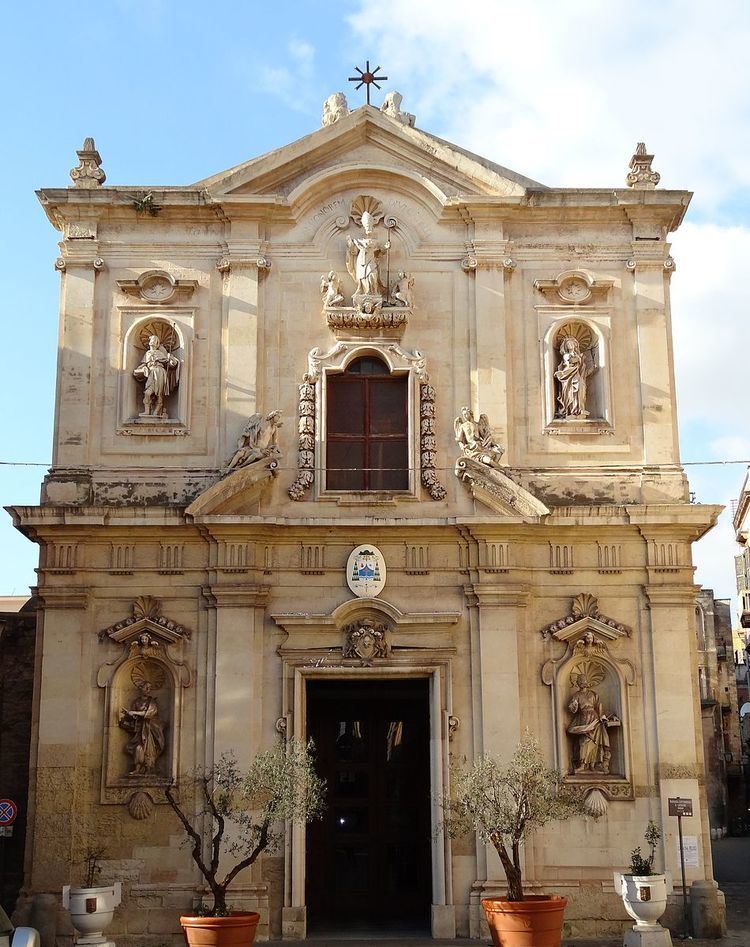Established 6th century Phone +39 099 470 9611 Country Italy Emeritus bishop Benigno Luigi Papa | Parishes 88 Area 1,056 km² Province Province of Taranto Archbishop Filippo Santoro | |
 | ||
Population- Total- Catholics (as of 2014)412,500415,500 (est.) (99.3%) Address Largo Arcivescovado, 8, 74100 Taranto TA, Italy Similar Basilica Cattedrale di San Ca, New Cathedral, Parrocchia San Pasquale, Parrocchia Santa Rita, Caritas Diocesana | ||
The Archbishopric of Taranto (Latin: Archidioecesis Tarentina) is a metropolitan Roman Catholic diocese in southern Italy, on a bay in the Gulf of Taranto.
Contents
- History
- Early 20th century
- Diocese of Taranto
- Archdiocese of Taranto
- since 1800
- Reference Works
- Studies
- Acknowledgment
- References
Its suffragan sees are the diocese of Castellaneta and diocese of Oria. The current Archbishop of Taranto is Archbishop Filippo Santoro, appointed by Pope Benedict XVI on 21 November 2011 to replace Archbishop Benigno Luigi Papa, O.F.M. Cap., whose resignation was accepted that same day.
History
In a local Tarantine legend, according to a document of the XI or XII century, the Gospel was preached in Taranto by St. Peter the Apostle. He had arrived in the city in AD 45, along with Saint Mark, on their way to Rome. Amasianus was a gardner or greengrocer, whom Peter converted to Christianity. It is only later, much later, that the Tarentines claim that Amasianus was consecrated a bishop. It is also stated that St. Cataldus was consecrated by St. Peter the Apostle. Whether Amasianus was the first bishop of Taranto, or whether it was Cataldus, in whose honor the Cathedral is dedicated, seems to be a pointless inquiry. As Lanzoni remarks, the stories are full of fables. The real Cataldus was an Irish bishop from Rachau (or Rachan) of the VI century, who happened to die in Taranto during his pilgrimage to the Holy Land.
The city also honors the martyr St. Orontius. Interestingly, Orontius, the son of an Imperial treasurer, had been converted to Christianity by Justus, a disciple of St. Paul, who had landed at the port of Saint Cataldus, and preached to the population in the locality of Lecce in the time of Nero, despite harassment by imperial officials. They returned to Corinth, where St. Paul consecrated Orontius the first Bishop of Lecce, and the party returned to Lecce to continue their evangelization.
The first bishop whose date is known is Petrus (not Innocentius) (496). In the pontificate of St. Gregory the Great (590–604), the names of three bishops who filled the episcopal chair are known: Andreas (590), Joannes (601), and Honorius (603). Archbishop Joannes (978) is the first who had the title of archbishop.
It is well known that Taranto even under the Byzantines never adopted the Greek Rite. Stephanus perished in the battle of Nelfi (1041) fought by the Greeks and the Normans; Draco (1071) erected the cathedral; Filippo (1138) was deposed for supporting the antipope Anacletus II, and died in the monastery of Chiaravalle; Archbishop Angelo was employed in several embassies by Innocent III; Jacopo da Atri was slain in 1370; Marino del Giudice (1371) was one of the cardinals condemned by pope Urban VI in 1385.
Cardinal Ludovico Bonito (1406) was one of the few who remained faithful to Gregory XII; Cardinal Giovanni d'Aragona (1478), was son of King Ferdinand of Naples; Giovanni Battista Petrucci suffered for the complicity of his father in the conspiracy of the barons; Cardinal Battista Orsini died in 1503 in the Castle of Sant' Angelo.
Cardinal Marcantonio Colonna (1560) introduced the Tridentine reforms and established the seminary; Girolamo Gambara (1569) was a distinguished nuncio; Lelio Brancaccio (1574) suffered considerable persecution on account of his efforts at reformation; Tommaso Caracciolo (1630), a Theatine, died in the odour of sanctity.
Early 20th century
The city of Taranto forms a single parish divided into four pittagerii, each of which contains a sub-pittagerio. It includes the Basilian Abbey of S. Maria di Talfano, where there are still some Albanians following the Greek Rite.
Diocese of Taranto
Erected: 5th Century
Latin Name: Tarentinus
Archdiocese of Taranto
Elevated: 10th Century
Latin Name: Tarentinus
